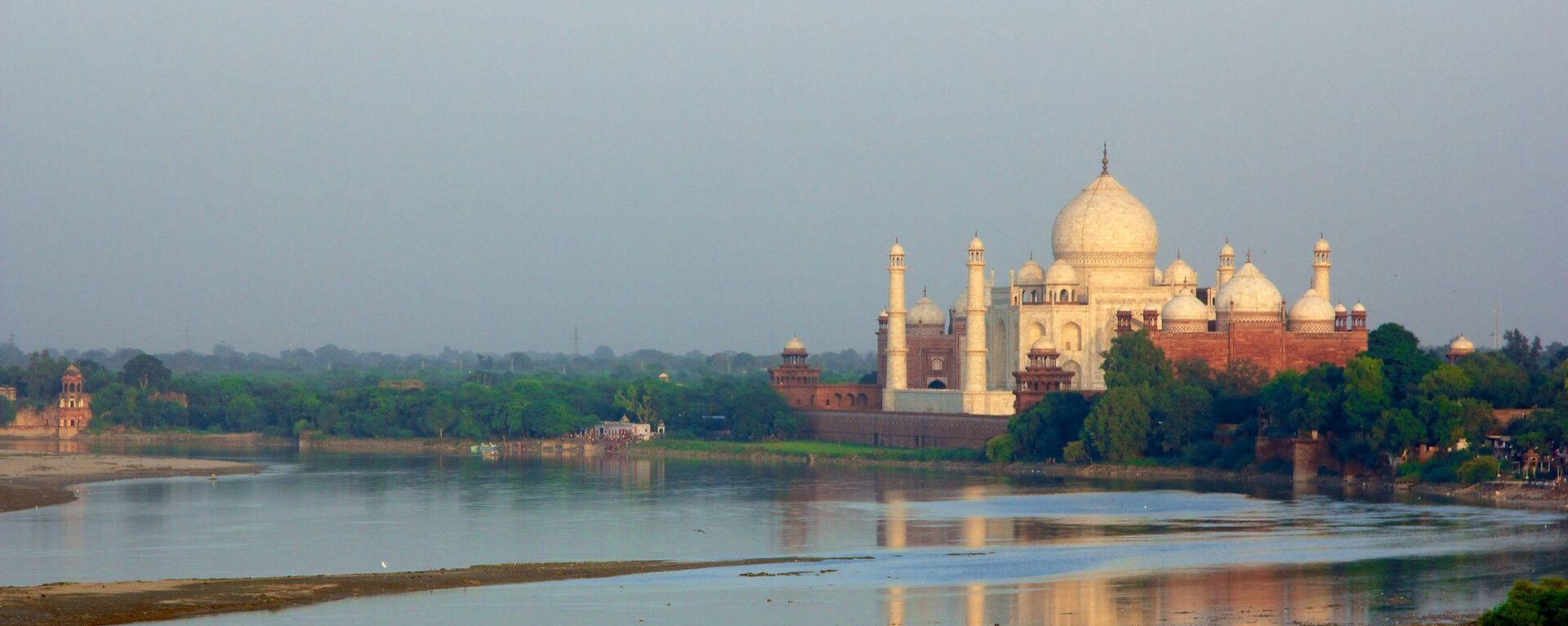https://sputniknews.in/20231129/archaeologists-launch-research-as-insects-turn-taj-mahal-green-5628522.html
Archaeologists Launch Research as Insects Turn Taj Mahal Green
Archaeologists Launch Research as Insects Turn Taj Mahal Green
Sputnik India
The formerly pristine white Taj Mahal, a World Heritage Site, is being marred by patches of green caused by a type of midge - the Goeldichironomus insect - shedding droppings on the marble surface and inlay work.
2023-11-29T12:29+0530
2023-11-29T12:29+0530
2023-11-29T12:29+0530
india
unesco
science & tech
environment
environmental crisis
plastic pollution
water pollution
air pollution
yamuna river (jumna)
climate change
https://cdn1.img.sputniknews.in/img/07e7/0b/1d/5631491_0:160:3073:1888_1920x0_80_0_0_d22ee693222f7e46aa0fa6dfd41db9f3.jpg
To tackle the issue of these insects swarming on the Taj Mahal and causing it to turn green, the Archaeological Survey of India (ASI) has initiated a comprehensive review aimed at finding a sustainable and lasting solution.Rajkumar Patel, a Superintending archaeologist, told Indian media that the ASI has been constantly working to eliminate the blemishes by carefully washing them with distilled water and gently rubbing them with a cotton cloth.However, despite their efforts, the insects continue to resurface during their breeding season, which occurs between March and April, as well as September and October.Due to this, the North wall of the World Heritage Site has been adversely affected.Patel added that the issue with insects has been a constant challenge since 2015, except for 2020 when the reduced pollution levels during the lockdown provided temporary relief.The chemical department of ASI is actively researching methods to halt the growth of insects.Moreover, an Agra-based doctor and environmentalist Sharad Gupta proposed an innovative solution by increasing water flow in the Yamuna river and reducing pollution levels.
https://sputniknews.in/20221220/for-first-time-in-history-taj-mahal-gets-property--water-tax-notices-164360.html
india
yamuna river (jumna)
Sputnik India
feedback.hindi@sputniknews.com
+74956456601
MIA „Rossiya Segodnya“
2023
Sangeeta Yadav
https://cdn1.img.sputniknews.in/img/07e6/0c/0f/110602_0:0:641:640_100x100_80_0_0_c298016a79eb02ef8caa9d1f688c12a5.jpg
Sangeeta Yadav
https://cdn1.img.sputniknews.in/img/07e6/0c/0f/110602_0:0:641:640_100x100_80_0_0_c298016a79eb02ef8caa9d1f688c12a5.jpg
News
en_IN
Sputnik India
feedback.hindi@sputniknews.com
+74956456601
MIA „Rossiya Segodnya“
Sputnik India
feedback.hindi@sputniknews.com
+74956456601
MIA „Rossiya Segodnya“
Sangeeta Yadav
https://cdn1.img.sputniknews.in/img/07e6/0c/0f/110602_0:0:641:640_100x100_80_0_0_c298016a79eb02ef8caa9d1f688c12a5.jpg
pristine white, taj mahal, world heritage sites, green patches, goeldichironomus insect, marble surface, inlay work, archaeological survey of india (asi), research study, sustainable, lasting solution, rajkumar patel superintending archaeologist, breeding season, drop in temperature, chemical department of asi, agra-based doctor, environmentalist sharad gupta, innovative solution, yamuna river, pollution levels
pristine white, taj mahal, world heritage sites, green patches, goeldichironomus insect, marble surface, inlay work, archaeological survey of india (asi), research study, sustainable, lasting solution, rajkumar patel superintending archaeologist, breeding season, drop in temperature, chemical department of asi, agra-based doctor, environmentalist sharad gupta, innovative solution, yamuna river, pollution levels
Archaeologists Launch Research as Insects Turn Taj Mahal Green
The formerly pristine white Taj Mahal, a World Heritage Site, is being marred by patches of green caused by a type of midge - the Goeldichironomus insect - shedding droppings on the marble surface and inlay work.
To tackle the issue of these insects swarming on the Taj Mahal and causing it to turn green, the Archaeological Survey of India (ASI) has initiated a comprehensive review aimed at finding a sustainable and lasting solution.
Rajkumar Patel, a Superintending archaeologist, told Indian media that the ASI has been constantly working to eliminate the blemishes by carefully washing them with distilled water and gently rubbing them with a cotton cloth.
However, despite their efforts, the insects continue to resurface during their
breeding season, which occurs between March and April, as well as September and October.
"Despite the decrease in temperature, the insects continue to reproduce and leave unsightly stains on the marble and inlay craftsmanship. Previously, the insects disappeared by October-end," revealed Rajkumar Patel, a Superintending archaeologist, in an interview with Indian media.
Due to this, the North wall of the
World Heritage Site has been adversely affected.
"This is not a uniform problem. It is restricted only to the
Taj's riverside face," Patel said.
Patel added that the issue with insects has been a constant challenge since 2015, except for 2020 when the reduced pollution levels during the lockdown provided temporary relief.
The chemical department of ASI is actively researching methods to halt the growth of insects.
Moreover, an Agra-based doctor and environmentalist Sharad Gupta proposed an innovative solution by increasing water flow in the
Yamuna river and reducing pollution levels.



